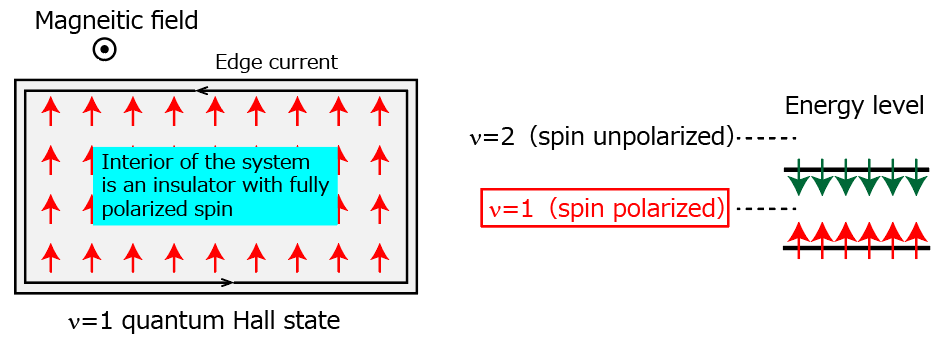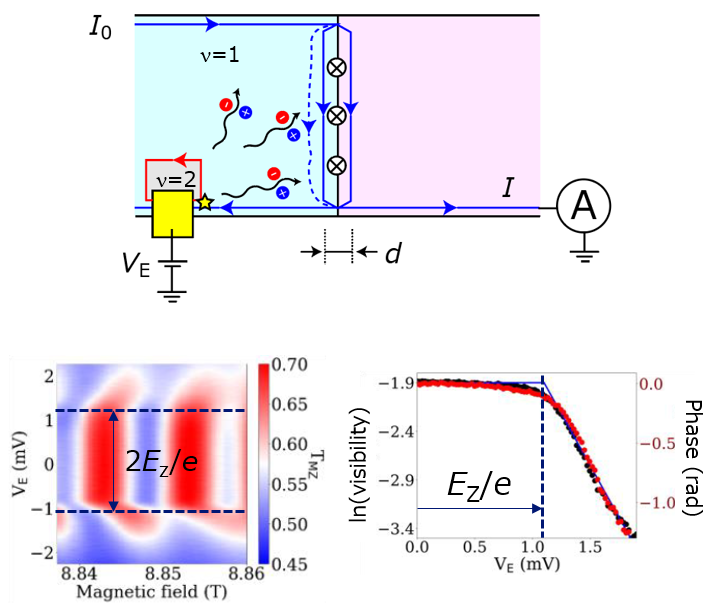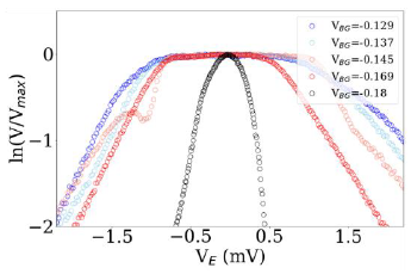Microsoft ends support for Internet Explorer on June 16, 2022.
We recommend using one of the browsers listed below.
- Microsoft Edge(Latest version)
- Mozilla Firefox(Latest version)
- Google Chrome(Latest version)
- Apple Safari(Latest version)
Please contact your browser provider for download and installation instructions.
December 8, 2021
Nippon Telegraph and Telephone Corporation
Elucidation of Spin Wave Physics Using a Graphene Electron Interferometer
-Contributing to Magnonics toward Ultra-low-power Devices-
[Overview]
Nippon Telegraph and Telephone Corporation (NTT), CEA-Saclay, and National Institute for Materials Science (NIMS) has successfully obtained knowledge on the process of spin-wave generation and the electrical control of spin waves in a graphene quantum Hall state*1. A spin wave is a phenomenon in which spin oscillation propagates in a magnetic material (Fig. 1). This process generates no Joule heat, so spin waves show promise for application to low-power devices. The technology that aims for device applications by controlling spin waves is called "magnonics" (magnon: a quantized spin wave). In this regard, a graphene quantum Hall state is an ideal research platform for the development of magnonics because it offers a simple and clean insulator, in which spins are fully polarized and disorder or crystal defects are extremely small. Furthermore, the spin state can be controlled between the fully polarized and unpolarized state (Fig. 2). The joint research group succeeded in detecting the amplitude and fluctuation of spin waves in a graphene quantum Hall state using an electron interferometer and thereby obtained a means of investigating the fundamental properties of spin waves. Feeding back the knowledge obtained from this system to application research will contribute to the development of magnonic devices. In addition, the knowledge obtained on the generation process of spin waves and electrical control of them could contribute to the realization of magnon quantum devices and magnonics new-principle devices. This research was published online in Nature Physics on 12, 8, 2021.
1. Background
In general, electronic devices perform information processing by controlling the flow of electrons (electric current). However, the resistance of metallic wiring and semiconductor elements increases as devices become smaller, resulting in a problematic increase in thermal energy loss. While spintronic devices with new functions have been achieved by using the flow of spins (spin current), most of these make use of the flow of electrons having spin, which does not solve the problem of thermal energy loss. Against this background, the field of magnonics that uses spin waves is attracting attention. A spin wave is a phenomenon by which spin current is carried without being accompanied by electric current. Therefore, magnonics show promise for application to ultra-low-power devices with no thermal energy loss. The research of magnonics is at the stage in which a variety of functions in different materials is being achieved along with discussions on the advantages and disadvantages of magnonics. A graphene quantum Hall state is an insulator having an extremely small amount of lattice defects and impurities with tunable spin state between fully polarized and unpolarized states. Thanks to these features, the graphene quantum Hall state is attracting attention as an ideal platform for fundamental research into the basic properties of spin waves.
2. Results
The joint research group detected spin waves with high sensitivity using an electron interferometer fabricated using a graphene p-n junction and successfully obtained knowledge on the generation process of spin waves and electrical control of them.
Applying a perpendicular magnetic field to graphene having a p-n junction results in the formation of a current channel that surrounds the p-n junction. At this time, the entrance and exit of the p-n junction each operate as an electron beam splitter resulting in an electron Mach-Zehnder interferometer (Fig. 3). A feature of the current measured with this interferometer is its highly sensitive response to slight changes in the area of the interferometer (a change in area of about 1 μm × 0.1 nm results in a change in current of about 70%). Most experiments are conducted at a Landau-level filling factor*2 ν = 1 state in which spins are fully aligned in one direction. By generating spin waves in association with electron-hole pairs in this ν = 1 state and having those spin waves collide with the interferometer, we investigated the characteristics of spin waves by measuring the resulting change in interference amplitude and phase. It was found that spin waves were generated stochastically following Poisson distribution (Fig. 4). This result indicates that spin waves appear not simply as waves but also as quanta (magnons) having the property of particles. We also showed change in spin-wave excitation energy when changing the spin state from the ν = 1 state by adjusting electron density (Fig. 5). In principle, this property can be exploited to enable spin-wave electrical control that has not been possible with conventional insulators, which should lead to the development of magnonics new-principle devices.
3. Technical points
We fabricated a p-n junction and electrodes for electrical measurements by laminating and fine processing graphene, hexagonal boron nitride (hBN), and metal electrodes (Fig. 6). In particular, by controlling the biases on the small gates fabricated at the entrance and exit of the p-n junction, we controlled the transmittance and reflectance of the beam splitters so as to maximize the sensitivity of spin-wave detection of the electron interferometer.
4. Future developments
We consider that a clean and simple system in the form of a graphene quantum Hall state can facilitate the research of spin waves and clarify their basic properties such as spin-wave velocity, attenuation mechanism, etc. We expect magnon-based quantum devices by which quantum information can be transmitted by magnons.
5. Publication Details
| Journal: | Nature Physics |
| Title: | "Unveiling excitonic properties of magnons in a quantum Hall ferromagnet" |
| Authors: | A. Assouline, M. Jo, P. Brasseur, K. Watanabe, T. Taniguchi, T. Jolicoeur, D.C. Glattli, N. Kumada, P. Roche, F.D. Parmentier, and P. Roulleau |
6. Glossary of terms
- Quantum Hall state
Applying a strong magnetic field perpendicularly to a two-dimensional electron system at low temperatures results in an electron state quantized into an integer value (integer quantum Hall effect) or fractional value (fractional quantum Hall effect) in which the Hall conductance is a multiple or fraction, respectively, of e2/h (h is Plank's constant). The current flows along the edge of the two-dimensional system and the interior becomes an insulator. - Landau-level filling factor
The ratio of electron density to a magnetic field (magnetic flux density). When the number of electrons and number of magnetic flux quanta are equal, ν = 1 and spins are aligned in one direction. When the number of electrons is twice the number of magnetic flux quanta, ν = 2 and spins are fully unpolarized.
 Fig. 1. Schematic of spin waves. Spin oscillations propagate like waves.
Fig. 1. Schematic of spin waves. Spin oscillations propagate like waves.
 Fig. 2. Graphene quantum Hall state. (left) The ν = 1 quantum Hall state in which spins are completely aligned in one direction. (right) Spin state can be changed from a spin-polarized state to a unpolarized state by changing the carrier density.
Fig. 2. Graphene quantum Hall state. (left) The ν = 1 quantum Hall state in which spins are completely aligned in one direction. (right) Spin state can be changed from a spin-polarized state to a unpolarized state by changing the carrier density.
 Fig. 3. (left) Optical Mach-Zehnder interferometer. Change in phase when passing through the sample changes the intensity of the transmitted light. (right) Electron Mach-Zehnder interferometer using a graphene p-n junction. The magnitude of the current changes according to the number of magnetic flux quanta penetrating the interferometer. This makes it possible to detect with high sensitivity the magnetic field and changes in in the area of the interferometer.
Fig. 3. (left) Optical Mach-Zehnder interferometer. Change in phase when passing through the sample changes the intensity of the transmitted light. (right) Electron Mach-Zehnder interferometer using a graphene p-n junction. The magnitude of the current changes according to the number of magnetic flux quanta penetrating the interferometer. This makes it possible to detect with high sensitivity the magnetic field and changes in in the area of the interferometer.
 Fig. 4. (upper) Diagram of experimental setup. Applying voltage VE to the metal electrode (yellow) generates spin waves, which can be detected by measuring the current passing through the interferometer. (lower left) Current passing through the electron interferometer. The interference pattern changes when VE exceeds the minimum voltage EZ/e for exciting spin waves. (lower right) Phase and visibility as a function of VE. The visibility decreases exponentially with respect to VE. This indicates that spin waves are excited stochastically following Poisson distribution.
Fig. 4. (upper) Diagram of experimental setup. Applying voltage VE to the metal electrode (yellow) generates spin waves, which can be detected by measuring the current passing through the interferometer. (lower left) Current passing through the electron interferometer. The interference pattern changes when VE exceeds the minimum voltage EZ/e for exciting spin waves. (lower right) Phase and visibility as a function of VE. The visibility decreases exponentially with respect to VE. This indicates that spin waves are excited stochastically following Poisson distribution.
 Fig. 5. Lowering electron density decreases the voltage at which interference intensity begins to change. This corresponds to a decrease in spin-wave excitation energy.
Fig. 5. Lowering electron density decreases the voltage at which interference intensity begins to change. This corresponds to a decrease in spin-wave excitation energy.
 Fig. 6. (left) Micrograph of the sample used. Many metal electrodes are attached to the graphene encapsulated by hexagonal boron nitride (hBN). (right) Cross sectional diagram of the sample, which has a laminated structure consisting of graphene, hBN, and metal electrodes.
Fig. 6. (left) Micrograph of the sample used. Many metal electrodes are attached to the graphene encapsulated by hexagonal boron nitride (hBN). (right) Cross sectional diagram of the sample, which has a laminated structure consisting of graphene, hBN, and metal electrodes.
For media inquiries regarding this matter, please contact
Public Relations Office
NTT Science and Core Technology Laboratory Group
science_coretech-pr-ml@hco.ntt.co.jp
Tel.: 046-240-5157
Information is current as of the date of issue of the individual press release.
Please be advised that information may be outdated after that point.
NTT STORY
WEB media that thinks about the future with NTT









